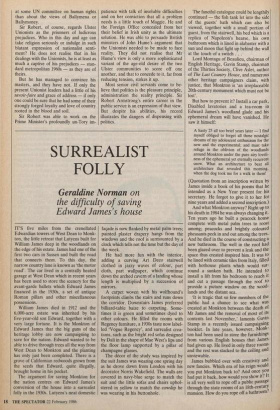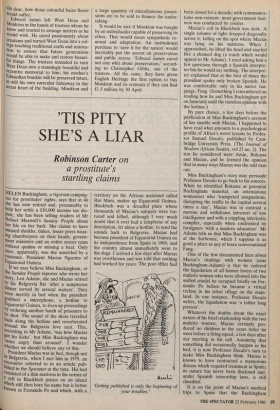SURREALIST FOLLY
Geraldine Norman on
the difficulty of saving Edward James's house
IT'S five miles from the crenellated Edwardian towers of West Dean to Monk- ton, the little retreat that Lutyens built for William James deep in the woodlands on the edge of his estate. James had one of the first two cars in Sussex and built the road that connects them. To this day, the narrow country lane is known as 'the motor road'. The car lived in a centrally heated garage at West Dean which in recent years has been used to store the scenery for the avant-garde ballets which Edward James financed in the 1930s, a set of antique Roman pillars and other miscellaneous possessions.
William James died in 1912 and the 6,000-acre estate was inherited by his five-year-old son Edward, together with a very large fortune. It is the Monkton of Edward James that the big guns of the heritage lobby are now campaigning to save for the nation. Edward wanted to be able to drive through trees all the way from West Dean to Monkton and the planting has only just been completed. There is a grove of Californian redwoods grown from the seeds that Edward, quite illegally, brought home in his pocket.
The argument for saving Monkton for the nation centres on Edward James's conversion of the house into a surrealist folly in the 1930s. Lutyens's neat domestic façade is now flanked by metal palm trees; painted plaster drapery hangs from the windows and the roof is surmounted by a clock which tells not the time but the day of the week.
He had more fun with the interior, adding a curving Art Deco stairwell clothed in jazzy waves of colour, part cloth, part wallpaper, which continue down the arched cavern of a landing whose length is multiplied by a succession of mirrors.
A carpet woven with his wolfhound's footprints climbs the stairs and runs down the corridor. Downstairs James preferred billiard-table baize to carpeting. Some- times it is green and sometimes dyed to other colours. He filled the rooms with Regency furniture, a 1930s taste now label- led 'Vogue Regency', and surrealist crea- tions, such as the bright red sofas designed by Dali in the shape of Mae West's lips and the floor lamp supported by a pillar of champagne glasses.
The decor of the study was inspired by the suit James was wearing one spring day as he drove down from London with his decorator Norris Wakefield. The walls are covered in navy-blue serge to match the suit and the little sofas and chairs uphol- stered in yellow to match the cowslip he was wearing in his buttonhole. The fanciful catalogue could be lengthily continued — the fish tank let into the side of the guests' bath which can also be viewed, together with a small portion of guest, from the stairwell, his bed which is a replica of Napoleon's hearse, his own bathroom which is lined in alabaster with a sun and moon that light up behind the wall at the touch of a switch . . .
Lord Montagu of Beaulieu, chairman of English Heritage, Gavin Stamp, chairman of the Thirties Society, Clive Aslet, author of The Last Country House, and numerous other heritage campaigners claim, with justice, that Monkton is 'an irreplaceable 20th-century monument which must not be lost'.
But how to prevent it? Install a car park, Disabled lavatories and a tea-room in Edward James's woodland glade and his ephemeral dream will have vanished. He saw it himself:
A hasty 25 all too brief years later — I find myself obliged to forget all those nostalgic dreams of my adolescent enthusiasm for the new and the experimental; and must take refuge in the oblivion of the woodlands around Monkton under the pure airy loveli- ness of the ephemeral yet eternally recurrent snow. What an architecture to beat all architecture that revealed this morning, when the dog took me for a walk in them!
(Quotation from an inscription written by James inside a book of his poems that he intended as a New Year present for his secretary. He forgot to give it to her for nine years and added a second inscription.) And what Monkton anyway? Right up to his death in 1984 he was always changing it. Ten years ago he built a peacock house complete with metal palm trees to roost among; peacocks and brightly coloured pheasants peck in and out among the trees. And he died in the course of constructing a new bathroom. The well in the roof had been glazed over to prevent a leak and the space thus created inspired him. It was to be lined with ceramic tiles from Italy, filled with hothouse plants which would sur- round a sunken bath. He intended to install a lift from his bedroom to reach it and cut a passage through the roof to provide a picture window on the wood- lands and the distant sea.
`It is tragic that so few members of the public had a chance to see what was created at Monkton between the death of Mr James and the removal of most of its contents last November,' laments Gavin Stamp in a recently issued campaigning booklet. In late years, however, Monk- ton had been used to store the furnishings from various English houses that James had given up. He lived in only three rooms and the rest was stacked to the ceiling and unviewable.
James bubbled over with creativity and new fancies. Which era of his reign would you put Monkton back to? And once you i had put it back, how would you show t? It is all very well to rope off a public passage through the state rooms of an 18th-century _ mansion. How do you rope off a bathroom? Oh dear, how those colourful baize floors would suffer.
Edward James left West Dean and Monkton in the hands of trustees whom he knew and trusted to arrange matters as he would wish. He cared passionately about creations and turned West Dean into a col- lege teaching traditional crafts and restora- tion to ensure that future generations would be able to make and restore beauti- ful things. The trustees intended to turn West Dean into a stunningly beautiful and eccentric memorial to him; his mother's Edwardian boudoir will be preserved intact, as will his own surrealist hideaway in the secret heart of the building. Monkton and a large quantity of miscellaneous posses- sions are to be sold to finance the under- taking.
It would be nice if Monkton was bought by an individualist capable of preserving its ethos. That would mean sympathetic re- newal and adaptation. An institutional purchase to 'save it for the nation' would inevitably put the accent on preservation and public access. 'Edward James cared not one whit about preservation,' accord- ing to Christopher Gibbs, one of the trustees. All the same, they have given English Heritage the first option to buy Monkton and its contents if they can find £1.5 million by 30 April.















































 Previous page
Previous page